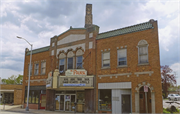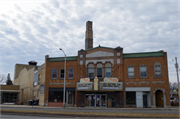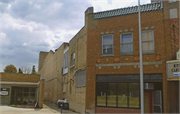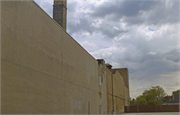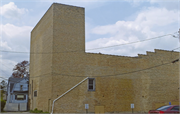Property Record
3015-3021 WASHINGTON AVE
Architecture and History Inventory
| Historic Name: | Capitol Theatre |
|---|---|
| Other Name: | |
| Contributing: | |
| Reference Number: | 120910 |
| Location (Address): | 3015-3021 WASHINGTON AVE |
|---|---|
| County: | Racine |
| City: | Racine |
| Township/Village: | |
| Unincorporated Community: | |
| Town: | |
| Range: | |
| Direction: | |
| Section: | |
| Quarter Section: | |
| Quarter/Quarter Section: |
| Year Built: | 1928 |
|---|---|
| Additions: | |
| Survey Date: | 20012015 |
| Historic Use: | theater/opera house/concert hall |
| Architectural Style: | Spanish/Mediterranean Styles |
| Structural System: | Brick |
| Wall Material: | Brick |
| Architect: | Dick and Bauer |
| Other Buildings On Site: | |
| Demolished?: | No |
| Demolished Date: |
| National/State Register Listing Name: | Not listed |
|---|---|
| National Register Listing Date: | |
| State Register Listing Date: |
| Additional Information: | A 'site file' exists for this property. It contains additional information such as correspondence, newspaper clippings, or historical information. It is a public record and may be viewed in person at the Wisconsin Historical Society, State Historic Preservation Office. Resurveyed 2015. Built in 1928 as Capitol Theater. Movie theater and vaudeville stage. Theater twinned in 1976, closed in 1986. 2016- "The Capitol Theatre is located on Washington Avenue on the far west side of the city of Racine in the neighborhood of West Racine (Figures 1 and 2). The building occupies the entire parcel on which it sits. A sidewalk parallels the north side of the property and a narrow alley runs the length of the east side of the property between it and a commercial building and parking lot. Additional parking lots are located to the west and south of the property. Residential parcels are located at the southern end of the west side of the property. Exterior The two-story Capitol Theatre was constructed in 1928.1 It has a rectangular footprint with an angled facade to conform to Washington Avenue (Figure 3). The building has a flat roof with a brick chimney stack. The rear portion, where the stage/screen was, is a story taller than the front of the building. The facade front Washington Avenue is divided into three sections consisting of a central pavilion housing the theater entrance flanked by a storefront bay on either side. The pavilion has a front gable roof that is capped in large tiles and is framed by wide brick pilasters. The pilasters have concrete caps. A decorative motif adorns the east pilaster. The pavilion's second story is brick with tiled and stucco panels. A prominent window display on the pavilion's second story consists of three one-over-one sash windows in arched openings. Each arch is framed in alternating bricks and concrete pieces, and Ionic pilasters flank the center window. Each of these windows has a relief motif set into the arch above the window opening. The theater marquee divides the first and second story of the pavilion. The marquee angles outward over the sidewalk and has a stepped, vertical panel of lights at its center. The sides of the marquee have backlit message boards with changeable lettering. Each side is topped by a backlit sign that reads "The Park." The theater entrance is glazed with two pairs of off-center glass doors with glass transom windows, and a plate glass display window is located to the west of the doors. The walls surrounding the entrance are clad in vertical wood siding. The flanking storefront sections each have a shallow, tiled, shed roof within the parapet. Both sections are divided into three fenestration bays and have a single brick dentil course directly below the shed roofs. The walls are brick and have decorative brick and tile panels below the second-story windows, and concrete belt courses above the storefronts. The second-story windows are one-over-one sashes. The east section's second-story windows are capped with lintels of alternating brick and concrete pieces. The east section's storefront has a transom window that consists of square glass lights and spans its full width. The east two bays are glazed with plate glass display windows resting on a tiled wall. The store entrance is angled and recessed in the westernmost bay. The west section's second-story windows are also one-over-one sashes, but are unevenly spaced. The eastern and central bays have lintels of alternating brick and concrete that match those on the east section; however, the outer, western window is set into an arched opening with a motif that matches those in the center pavilion. The distinction between the western window bay and the other two bays is also enhanced by a small break in the belt course. The window's arch is mirrored on the bay's first story, which consists of an entrance recessed within an arched entryway. The arch is comprised of composite pilasters that are topped by alternating brick and concrete pieces on the outside of the arch and narrow concrete pieces on the inside. A storefront occupies the eastern two first-story bays of the west section. The easternmost bay is glazed with a large, plate glass display window resting on a tiled wall. The central bay has an angled, recessed pedestrian door. The remaining storefront wall is clad in vertical wood siding. The east, west, and south elevations consist of brick walls with minimal fenestration. The east elevation has a stepped parapet near the center of the elevation. A pair of one-over-one sash windows is located on the second story of the north end, with a single one-over-one sash window below.To the south of the paired windows is an enclosed porch with a doorway and two plate glass windows, and is clad in horizontal siding. A window is located below that has been infilled. A single one-over-one window is located towards the south, rear portion of the east elevation, and several paired doors are located below grade along the elevation. The rear, south elevation has paired doors on the east and west ends of the first story, and a long, narrow window above a concrete block-filled portion towards the west side. The west elevation has a stepped parapet that mirrors that on the east elevation, and paired, single windows towards the north end. The approximate northern one-third of the west elevation has been covered in stucco. Interior The main entrance of the theater, located below the marquee in the central pavilion section, opens onto a long, narrow lobby. The floor is tiled and the ceiling is coated in plaster with a rough finish. The side walls are divided into sections by pilasters, which are topped by an entablature with ornamental plaster running the length of the lobby. Within each segment is a rectangular panel, with ornamental plaster along the edges and glass-front display units in the center, which are also surrounded by ornamental plaster and topped by hooded light fixtures. To the rear of the lobby is a small foyer with an arched ceiling and ornamental plaster along the cornice. Small restrooms are located on the east and west sides of the foyer. The projection room is located above the foyer. The original theater auditorium is located behind the foyer. The interior of the auditorium has been heavily altered from its original configuration. In 1975 and 1976, the theater was divided into two separate screening rooms? This was accomplished by bisecting the main theater down the center, from north to south. A partition wall was installed by cutting directly through the oval, coffered, plaster ceiling. The coffered ceiling contains ornamental plasterwork along the interior margins, and decorative stenciling is located between the coffer and exterior corners of the auditorium. In addition to loss of original material, there are many holes and other damaged areas in the ceiling. Other alterations have included installing a new wall at the front of the theater for the projection screen, installing fabric panels on the walls, and installing a ventilation system and drop ceiling, which also resulted in significant damage to the plaster ceiling. Some ductwork, and the metal skeleton of the drop ceiling and several ceiling panels remain. No theater seats remain in the building. Behind the projection screen wall is the original stage/screening area of the theater, which was not as impacted by the interior remodel. Segments of the original plaster on the walls remain, including fluted pilasters and large panels outlined in ornamental plaster that reach from the floor to the ceiling. A large pilaster on each side, with paired brackets, supports a large arch spanning the width of the theater that has ornate plasterwork. A portion of the large, coffered ceiling is visible, although it was also bisected by the projection screen wall. To the front of the coffer is an ornate ventilation grill surrounded by stenciling. The stage is surrounded by a large, wide proscenium arch that is covered in ornamental plaster, which is painted in many places. Above and to the front of the stage is an oblong ceiling coffer. To the sides, and slightly in front of, the stage, are two opera boxes. These are also set within arches that have ornamental plaster, and above each arch is a decorative plaster wreath and garland." -"Robert Mosely and Minerva Walker House", WISDot #2440-09-00, Prepared by Scott Slagor and Katie Remensnyder for Commonwealth Heritage Group, (2016). |
|---|---|
| Bibliographic References: | “Park I and II Theater.” Accessed April 1, 2015. www. http://cinematreasures.org/theaters/7439. |
| Wisconsin Architecture and History Inventory, State Historic Preservation Office, Wisconsin Historical Society, Madison, Wisconsin |

